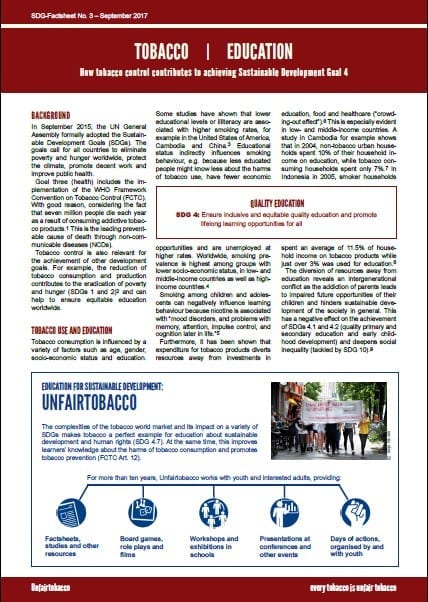Poor, hungry, addicted to tobacco
Our first SDG-Factsheet explains how poverty and hunger are linked to tobacco.
Read moreOn the occasion of the International Literacy Day, we publish our third SDG-Factsheet and focus on Sustainable Development Goal 4 (“Quality Education for All”).
Tobacco use is influenced by a variety of factors, among them social and economic status, but also education. The level of education indirectly influences smoking behaviour, e.g. because less educated people
Worldwide, smoking prevalence is highest among groups with lower socio-economic status, in low- and middle-income countries as well as high-income countries.
Furthermore, money spent for tobacco products is not available for other expenditures. Diverting these resources away from education is especially evident in low- and middle-income countries. This reveals an intergenerational conflict as the addiction of parents leads to impaired future opportunities of their children.
90% of the global tobacco leaf harvest is produced in the Global South, e.g. in Malawi, Brazil, and India. Smallholder farmers have difficulties in making a living from tobacco growing. Often, their earnings are so low that there is no money left to pay workers or sustainably improve their living conditions. So, many smallholder farming families turn to their children for help in the fields.
Tobacco growing is a very hazardous work for children: exhausting and harmful to health due to the use of chemicals and the nicotine from the tobacco plant. Injuries and poisonings, in addition to the time used for work, impact on children’s rights to education and leisure. At the same time, learning and formation are needed to break the cycle of poverty and the dependence on tobacco companies.
The tobacco world market is complex, the consequences of tobacco growing and tobacco use are manifold. The whole value chain impacts on a variety of SDGs. For this reason, we use tobacco as an example for our education programme on sustainable development and human rights, while promoting tobacco prevention.
Apart from learning resources which can be used in class, we offer workshops in schools, support students in organising days of action, prepare background information, and give presentations.
Graen (2017): SDG-Factsheet No. 3: Tobacco | Education (PDF)
Graen/Eichborn/Tümptner (2017): Graphic Education for sustainable development (JPG)
Both ends of the tobacco value chain point to an intergenerational conflict and a vicious cycle of poverty that needs to be broken.
